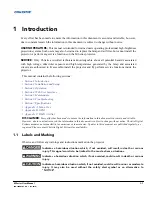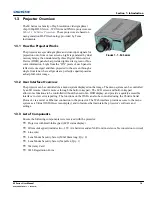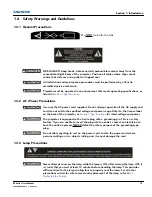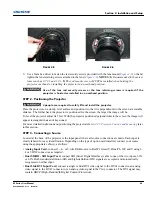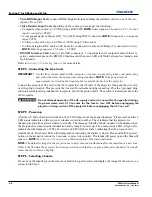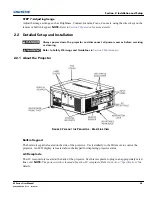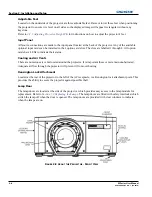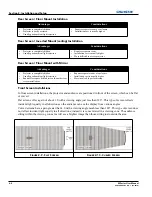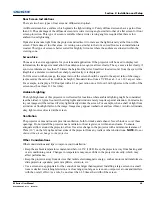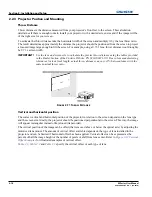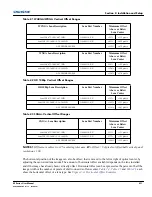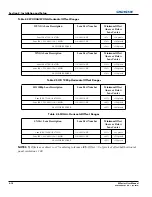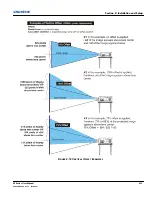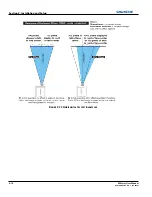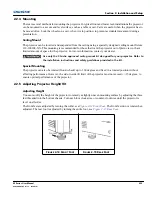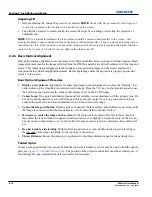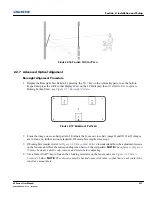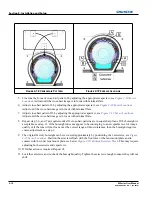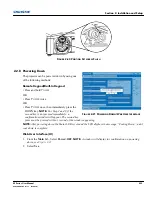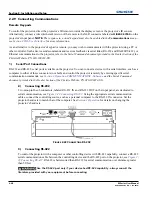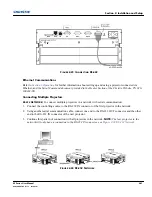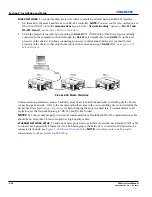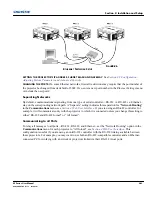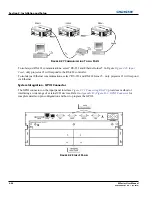
Section 2: Installation and Setup
M Series User Manual
2-9
020-100009-05 Rev. 1 (09-2010)
Rear Screen Installations
There are two basic types of rear screens: diffused and optical.
A diffused screen has a surface which spreads the light striking it. Purely diffused screens have a gain of less
than 1.0. The advantage of the diffused screen is its wide viewing angle, similar to that of a flat screen for front
screen projection. This type of screen is suitable when a wide viewing angle is required but there is low
ambient room lightening.
Optical screens take light from the projector and redirect it to increase the light intensity at the front of the
screen. This reduces it in other areas. A viewing cone, similar to that of a curved front screen installation is
created. This type of screen is better suited for brightly lit rooms where the audience is situated within the
viewing cone.
Screen Size
Choose a screen size appropriate for your lens and application. If the projector will be used to display text
information, the image size must allow the audience to recognize all text clearly. The eye sees a letter clearly if
eye-to-text distance is less than 150 times the height of the letter. Small text located too far from the eye will be
illegible at a distance no matter how sharply and clearly it is displayed.
To fill a screen with an image, the aspect ratio of the screen should be equal to the aspect ratio of the image
(expressed as the ratio of its width to its height). Standard video from a VCR has a 4:3 or 1.33:1 aspect ratio.
For example, to display a VCR output with a 4:3 aspect ratio onto a 10-foot (3m) high screen, the width of the
screen must be at least 13.3 feet (4m).
Ambient Lighting
The high brightness of this projector is well suited for locations where ambient lighting might be considered
less than ideal. A typical room with ceiling lights and windows rarely requires special attention. Contrast ratio
in your images will be reduced if stray light directly strikes the screen. For example, when a shaft of light from
a window or floodlight falls on the image. Images may appear washed out and less vibrant. Avoid or eliminate
stray light sources directed at the screen.
Ventilation
The projector vents and louvers provide ventilation, both for intake and exhaust. Never block or cover these
openings. Do not install the projector near a radiator or heat register, or within an enclosure. To ensure
adequate airflow around the projector, allow free air exchange to the projector with a minimum clearance of
25cm (10”) on the left, right and rear sides of the projector from any walls or other obstructions.
NOTE:
Do not
obstruct the air exchange to the projector.
Other Considerations
Other considerations and tips to improve your installation:
• Keep the ambient temperature constant and below 40
°
C (104F). Keep the projector away from heating and/
or air conditioning vents. Changes in temperature may cause drifts in the projector circuitry, which may
affect performance.
• Keep the projector away from devices that radiate electromagnetic energy, such as motors and transformers,
slide projectors, speakers, power amplifiers, elevators, etc.
• Use a screen size appropriate for the venue but not larger than required. Installing a large screen in a small
room is similar to watching television at a close range; too large a screen can overpower a room and interfere
with the overall effect. As a rule, be no closer than 1.5 times the width of the screen.
Summary of Contents for M Series
Page 1: ...M Series U S E R M A N U A L 020 100009 05 ...
Page 2: ......
Page 3: ...M Series U S E R M A N U A L 020 100009 05 ...
Page 14: ......
Page 46: ......
Page 120: ......
Page 131: ...Section 6 Troubleshooting M Series User Manual 6 7 020 100009 05 Rev 1 09 2010 FIGURE 6 1 ...
Page 132: ......
Page 148: ......
Page 152: ......
Page 167: ......

